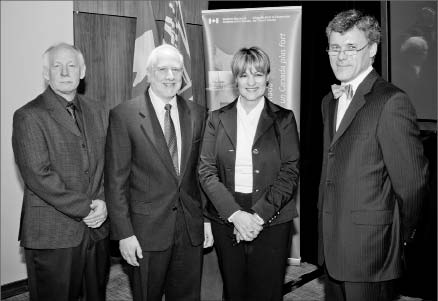The Canadian government is spending $1.8 million to fund a new geophysical survey technology from Vancouver called muon geotomography.
Developed by University of British Columbia (UBC) professor Douglas Bryman with the help of the research group Advanced Applied Physics Solutions (AAPS), the technology uses cosmic ray muons – subatomic particles which penetrate deep into the earth – to identify and model high-density mineral deposits.
The technology has the federal government so excited it sent Minister of State for Western Economic Diversification Lynne Yelich to make the announcement in Vancouver’s Fairmont Pacific Rim hotel on March 17. She has been a Conservative Member of Parliament for the Saskatchewan riding of Blackstrap since 2000 and a cabinet member since 2008.
“With mining being so important to our country’s economy, our government must do its part to ensure it remains a competitive, job-providing sector. We need to support better means and methods of exploration to discover reserves and to help stimulate mining exploration in Canada. We need to look at funding research in this area as an investment,” Yelich told the 30-person crowd sprinkled with members of Vancouver’s mining industry.
Yelich says people have started to call her the “potash queen” because she has “the most potash mines (of any) riding.”
Bryman took to the podium to describe his new technology. He holds UBC’s J.B. Warren Chair for experimental particle physics, has patents for gamma-ray and muon technologies as well as other imaging technologies, and is described as a leader in advanced instrumentation development for experiments in nuclear particle and applied physics.
Muon geotomography, explained Bryman, is “unprecedented (as a) geophysics application and has functionality down to around 1 km. It is a non-invasive, environmentally friendly technology that we believe will greatly reduce drilling costs for the mining industry.”
Bryman says the technology harnesses the natural power of muons, which are heavy electrons produced in the upper atmosphere that come down in relatively straight lines to penetrate deep into the earth. By reading the attenuation of the cosmic rays through matter – or more simply, by calculating how the muons slow down as they pass through different mineralization below the surface – Bryman’s technology can produce images of orebodies. The more attenuation, the denser the mineralization is.
“The function in this case is to allow us to essentially do CAT scans of the earth,” elaborated Bryman, who argues the principles are the same as a CAT scan on a human body and allow for beautiful images and 3-D models of orebodies.
When asked how muon geotomography compares with other geophysical surveys currently used by the mining industry, Bryman replied it uses different principles and should be able to provide a more accurate map of a deposit.
Unlike other techniques, his measures density, since certain concentrations of density are often indicators of valuable mineral deposits. He says this can provide a more precise target based on a high-density location so that drilling can be more efficient and “basically isn’t a random process.”
For now, however, the technology is limited to brownfield projects such as underground mines where Bryman’s sensors can be placed at different intervals. Still, Bryman’s team is working on developing borehole instruments so that the technology can eventually be used on greenfield projects, where underground access is limited or non-existent. But that will take another few years.
Breakwater Resources (BWR-T) hosted the field trial phase for the new geophysical survey at its Myra Falls mine near Campbell River, B.C., where it produces zinc, copper, lead, gold and silver from massive sulphides. As Dave Keiver, human resources superintendent at Myra Falls, explained, “We are extremely pleased to be able to host a test site of this technology. Having this (survey) confirm what we think is already there is, to say the least, exciting.
“The impact that it has on our industry and our operation in particular is significant. When you’re doing diamond drill holes and you’re pretty much putting that large string of steel into that haystack and hoping that you’re hitting that something, geology traditionally will give you a pretty good sense of what is out there, but having this sort of information would be just economically phenomenal for us.”


Be the first to comment on "Federal government funds ‘CAT scan for the earth’"